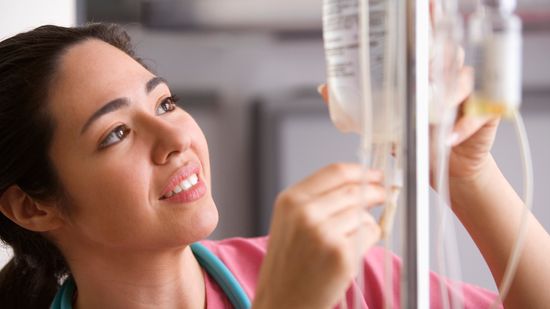Life Science
From the smallest microbe to the largest mammal, Life Science explores the origins, evolution and expansion of life in all its forms. Explore a wide range of topics from biology to genetics and evolution.

Central Heterochromia: When to Worry About Eye Color

10 Types of Noses to Spot in a Crowd

3 Major Types of Mushrooms: Edible, Wild and Poisonous

3 Types of Trees You'll Find All Over the Planet

A Corpse Flower Can Grow Over 12 Feet (3.7 Meters) Tall

Indica vs. Sativa: How to Distinguish Between Cannabis Plants

In Vivo vs. In Vitro Trials (and Why Combining Both Is Best)

Hypertonic vs. Hypotonic Solutions: Differences and Uses

Your Phone Is a Germ Factory, So Stop Taking It to the Toilet

Neanderthal vs. Homo Sapien: Separate Species With Different Fates

Howstuffworks Interviews: Extinction Level Events with Annalee Newitz

What will the Earth look like in 50,000 years?

Is a Woolly Mammoth Clone Even Possible?

The Most Common Hair Color Isn't Blonde

What Is the Most Common Eye Color? Over 70% of People Have It

9 Types of Intelligence: The Many Ways to Expand Your Mind

Phineas Gage and the Birth of Modern Neuroscience

Call of the Void: A Counterintuitive Form of Self-preservation
Learn More / Page 4
Whether you belt out a tune in the shower, at a karaoke bar or in a choir, singing has some real, tangible health benefits. But can it also make you happy?
By Julia Layton
Would you be happier if you had the perfect body? A better job? A bigger paycheck? Being happy with yourself is less about the pursuit of happiness and more about finding it within you.
Predicting the future is a tricky business. We've long been promised flying cars and robot maids, only to be disappointed year after year. What might the crystal ball have in store for us in 2050?
Advertisement
Of course they can. They do it every day when they wag and meow their undying love for you. Why are pets such a solid prescription for smiles?
Whether it's "Happy," "Baby Shark," or "Call Me Maybe," some tunes just live rent-free in your brain. But why do songs get stuck in your head?
We talk about morals in relation to raising children, voting for political candidates and criticizing people who don't see eye-to-eye with us. But is morality even a choice? Or is it all in your head?
There are people who are smart, and there are people who are people-smart. The guy you want in your think tank isn't necessarily the same person you want at your birthday party. But can emotional intelligence say more about your brain than IQ can?
Advertisement
Do gender differences go beyond our reproductive organs? Popular culture would have you believe that men are from Mars, while women call Venus their planet of birth. Is it possible to finish the argument of nature versus nurture?
Compare neuroscientists with crackerjack detectives like Nancy Drew and Hercule Poirot, and the brain docs might come up short. After all, they have yet to crack the case on five big brain mysteries.
Laugh and the world laughs with you, the saying goes. In our image gallery, experience the range of human emotions from around the world.
You only use 10 percent of that big, wrinkled mass of smarts -- unless you listen to Mozart. At least, that's what we've heard about the brain. But how many common brain beliefs are just plain wrong?
Advertisement
Parents just don't understand. Scientists didn't understand either, until they got a good look inside the teenage brain -- and what they saw turned what we thought we knew on its head.
We've all seen the effects that hatred has on our society, but just what is this destructive emotion? And can it be overcome?
By Alia Hoyt
A mass extinction on Earth is long overdue, according to population ecologists. Find out what Earth's fossil record may be telling us about our future.
By Josh Clark
When you see someone else yawn, you often find yourself doing it. Yawning is contagious. But what does that have to do with the ability to feel empathy?
By Josh Clark
Advertisement
The results of three recent studies show that an uncircumcised man is twice as likely to contract AIDS from an infected woman as is a circumcised one.
By Julia Layton
With an ever-increasing number of studies finding a direct connection between sleep deprivation and weight gain, it's difficult to deny the cause-and-effect relationship.
By Julia Layton
Even if you're very ticklish, you probably are incapable of tickling yourself. Learn why.
Nature uses color in lots of different ways. Find out why some types of cabbage are purple and what this means.
Advertisement
How can children from the same parents look so different? I mean, why don't all kids from the same parents look exactly alike, since the parents just have one set of chromosomes each and they don't change?
Ever since I took biology in high school I have wondered -- why do humans (and plants and animals) have two of every gene, and why is one "dominant" and the other "recessive"? How does my body know which one is dominant? How does it pick between the
Evolution is fascinating because it attempts to answer one of the most basic human questions: Where did life, and human beings, come from? The theory of evolution proposes that life and humans arose through a natural process.
The physical you is a result of your DNA, and your DNA is part of the human gene pool. Find out what the "gene pool" really is and what happens when it shrinks.
Advertisement
HIV continues to be a major global public health issue, having claimed more than 35 million lives so far.
By Kevin Bonsor & Oisin Curran
Whether brain death is a result of cardiac arrest and lack of oxygen to the brain, or of a gunshot wound to the head, the diagnosis is the same. Learn what the term "brain dead" actually means.
























